
This book has a great table of contents
What if you found a book that didn’t have a table of contents and the chapters were randomly arranged?
It would be pretty hard to find what you were looking for…
The book would be far more useful if there was some structure.
So imagine a website that didn’t have an easy to follow structure…
(As I write this, I clearly see that Niche Site Project can use some organization!)
What is siloing all about?
It’s simple. Siloing is all about organization.
Organizing a website is important for a two main reasons:
- A Positive User Experience: If you organize your site well, then the users will have an easier time navigating through your website.
- The SEO Benefits: A well organized website, one with a silo architecture, gives search engines a great deal of support about the topics that the website covers. In other words, Google will have a very good idea about what niche your website is relevant to.
Fortunately, the two drivers go well together and there are very few cases where the efforts are conflicting.
The bottom line is that if you organize a site in a logical way the users and search engines will like it. You can even use content silos on your Amazon Affiliate Marketing Websites.
Definition: What is a Silo?
A silo is a way to design and organize a website so that topics and related information are grouped together. You can think of siloing as a way to organize the content of a website in a systematic way.
It takes careful planning – this isn’t just building a website quickly without any forethought. This is website architecture.
If you’re impatient, here is a quick illustration of what it might look like:
And the text version:
- example.com/topic–1
- example.com/topic–1/subtopic–1
- example.com/topic–1/subtopic–2
- example.com/topic–1/subtopic–3
- example.com/topic–1/subtopic–4
- example.com/topic–1/subtopic–5
- example.com/topic–2
- example.com/topic–2/subtopic–1 . . .
- example.com/topic–2/subtopic–5
- example.com/topic–3
- example.com/topic–3/subtopic–1 . . .
- example.com/topic–3/subtopic–5
…and, so on…
Is it worth the extra effort? Let’s look at why we might do this.
Benefits: Why use a Silo?
The top reason to use a silo is the SEO benefits. The search engines look favorably on websites that have subject matter that is tightly focused – that makes it easy to interpret what the website is about. The structure will help pass the link juice exactly where it’s needed to rank your main keywords. The theory is that the link juice will be extremely relevant since the interlinking topics are closely related.
A secondary reason is that siloing will provide a better user experience. Why? Well, the content will be organized so that it’s easy to navigate around to find related and relevant information. Alternatively, if you don’t plan out the site architecture, you will often end up with all your content in posts. That leads to a hard-to-navigate website, just like the book without a table of contents.
Disclaimer: I don’t have first hand experience with a completely implemented, successful silo’ed website. However, the logic is sound and the proponents seem to be doing very well with their silo’ed money sites. Anyway, proceed at your own risk.
Summary of Part 1
- A silo structure for a website is a way to organize the content of the site in a logical way.
- The silo structure creates a good user experience for the site since it’s generally easier to navigate.
How to Implement a Silo
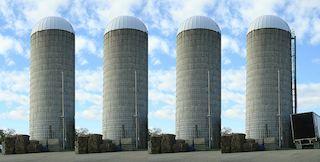 This is Part 2 of the Silo Series about a building a website with a silo’ed structure. If you are just joining the conversation, go back to the first part so you can catch up.
This is Part 2 of the Silo Series about a building a website with a silo’ed structure. If you are just joining the conversation, go back to the first part so you can catch up.
Let’s consider a situation where you’re starting a brand new site. You have a blank canvas and can structure the website however you would like. This initial structure will be the entire foundation of your website.
It’s even more important to get the structure correct if the website will be an authority site or if there will be a large number of posts or pages.
WordPress Doesn’t Natively Support Silos
WordPress has tags and categories but they aren’t specifically helpful for silos. It would be super cool if there was a silo classification but there isn’t.
There are some common concepts between categories and silos but a few things are missing. You could probably get something usable with a little tinkering with the permalink structure along with the categories.
Maybe Plugins?
But inherently there is not a way to build a silo site out of the box with WordPress. Some plugins are available to help set up a silo but I haven’t tried any of them. If you have, let me know.
I assume the plugins would use categories, posts, pages, and the permalink structure to set up the site architecture. Ideally, they would automatically add a links on the main silo pages for new content whenever it is added.
Luckily, we can set up a silo effectively without any special tools as long as we have a solid plan upfront.
Overview
My approach is simple.
The upside is that you can keep it straightforward and not use any plugins.
The downside is that there is more administrative work when you add more content to the site. That’s not really a problem unless you plan on having a very large site – then it could be tedious.
Consider these 3 steps:
- First, do your keyword research following the Keyword Golden Ratio. Do it in a very thorough manner so you have a lot of long-tail keywords.
- Next, use pages, not posts, and utilize a parent-child hierarchy.
- Last, link out to other content on your site.
That’s pretty much it at a high level. And, if you’re thinking that’s too simple, don’t worry, there are a ton of details to get obsessed with.
Remember our example from before? Keep it in mind and it should help to keep this silo concept clear in your mind.
And the text version:
- example.com/topic–1
- example.com/topic–1/subtopic–1
- example.com/topic–1/subtopic–2
- example.com/topic–1/subtopic–3
- example.com/topic–1/subtopic–4
- example.com/topic–1/subtopic–5
- example.com/topic–2
- example.com/topic–2/subtopic–1 . . .
- example.com/topic–2/subtopic–5
- example.com/topic–3
- example.com/topic–3/subtopic–1 . . .
- example.com/topic–3/subtopic–5
…and, so on…
The Structure – Pages
You can probably tell what we are trying to acheive based on the illustration. It isn’t overly complicated if we just use pages in WordPress instead of posts.
Pretty simple, right? So… topic–1, topic–2, and topic–3 would be pages.
We will consider them as the main silo pages – all the content of the site falls under these main silo topic pages.
All of the subtopics (subtopic-X) would also be pages. The subtopics would have a “parent” page (main silo topic pages) the set in the Page Attribute section in WordPress. The parent page would align each of the subtopics (children) to its parent topic.
You can also extend this further by having subtopics for the subtopics. WordPress does not have a limit for the number of nested pages. That might look like this:
- example.com/topic–2/subtopic–5/another-subtopic–1
- example.com/topic–2/subtopic–5/another-subtopic–2
- example.com/topic–2/subtopic–5/another-subtopic–3
Simply setting up the page hierarchy with parent and child pages (and grandchildren), will provide the exact structure we need for a silo. Generally, you want to keep the structure at three or layers or less.
If you have a site that is very large you could potentially expand farther. While WordPress does not support silo structures natively, the parent-child hierarchy for pages works out great.
Note: There are other popular options that we will skip for now. For example, one uses posts for the content and pages to replace the category page. Another uses posts for content and category pages for the main silo pages. Those options require a little more setup, potentially some php edits, but then the category pages will be updated automatically.
The Keywords
The keywords bring it all together. The site will be organized by keywords. You need to have a very good handle of the keywords that the site will be targeting. It doesn’t have to be all inclusive but you should have a list of main keywords that you are targeting.
Go For The Longtail
You should also have secondary keywords, too. And, deep dive into the long tail of niche – even look for the keywords that have a very low volume of exact monthly searches. During your research, check out the keywords that the competing websites are targeting as well.
There is not a minimum number of keywords but if you find that you don’t have very many keywords, then try to figure out why. Either you need to look harder and find more long tail keywords or the niche does not lend itself to that many keywords.
How many keywords do you need? If you cannot find at least 5 subtopics for most of the parent pages, then a silo structure may not be worth the effort to fully implement. You can still follow most of the guidelines, maybe not as strictly, in case the site expands.
That said, the common wisdom is to keep your structure no more than 2 – 3 levels deep so that the child pages will be able to get enough links.
Interlinking the Website
The structure is only part of the equation. It would be too easy to simply set up some parent and child pages.
The thing that makes this whole setup work is the interlinking of the pages. There are a few theories and methods on the best way to have the pages interlinked to pass the maximum amount of link juice. Some of those methods are very strict about where links appear on the page and what pages can link to other pages.
If you just link naturally when related topics arise in the content then, that would satisfy the user experience aspect. I slightly favor this approach since it is never a bad thing to have a positive user experience.
So, if you just structure the pages like we see in the example above and link to your related articles every chance you get, then your site should have a great silo structure with adequate interlinking.
Guidelines to interlinking
There are some guidelines to keep in mind for interlinking within your website. This is easier to see in a illustration.
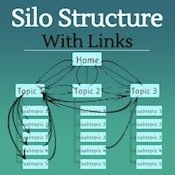
Silo Sample Structure Interlinking – Click for Larger Image
Let’s consider the the child pages.
The individul content pages (child) should all link back up to the main silo page (parent).
The individul pages can link to other pages in the same silo – even to all the other pages – and to any of the other main silo pages (the uncle/aunt pages).
The child pages should not link directly to pages that are not in the same silo (cousin pages). Instead, they should link to the main silo page (uncle/aunt) for that page (cousin).
The silo pages (parent) should link to all of the pages in their silo (all the child pages).
The silo pages (parent) can optionally link to the other silo pages (sibling).
I like to keep things simple so I generally place the links within the text content of the pages. Some people follow very specific rules about where to place the links. The specific rules are things like, parent pages should only link to the childen pages in the sidebar or at the bottom of the page. Or, children pages link to the parent page in the first paragraph.
Adding Content & Ongoing Maintenance
Planning upfront for your website is extremely important as you can tell. If you plan well then it should be pretty easy to add more content to the site and stick to the sil structure. Generally, new content (i.e. the content added after launching your site) that is added to the site should probably fit into the silo structure that you planned…
You did your keyword research, right?
Well, things change and sometimes your site will publish content beyond original keyword research. Or, maybe the website has just taken off and grown over time so you are publishing content that doesn’t fit into the current silo structure. We can take care of that too.
Let’s look at the first instance: adding content after site launch that fits into the silos structure.
- Add the page with the new content.
- Be sure to select the correct “Parent” page (which should be a main silo page) to adhere to the site architecture that you have carefully planned.
- The page (a child) should have links that contain appropriate interlinking within the website. At a minimum, that means there should be a link to the main silo (parent) page. Optionally, there can be links to some or all of the sibling pages, and the page can also link to the other silo (uncle/aunt) pages as well.
- The silo (parent) page will need to be updated with a link to the new child page. This is not optional and is very important to help get the new page indexed quickly.
Now, the second scenario is when you are adding content that does not fit into an existing silo.
- Once you identify a topic that can’t be included in an existing silo, it means you should do more keyword research. You need to find as many other keywords and topics to write about that are related.
- The goal is to identify enough new article topics so that you can create a new silo. If you can identify 5 or more new pages based on the keyword research, then you should create a new silo.
- You need to add the new silo (parent) page of the silo to the main navigation of the site.
- The new silo (parent) page of the silo can optionally have links to the other silo pages.
- After you have the main silo page set up, the silo will be managed in the same exact way.
Summary of Part 2
In Part 2 of the Silo Series, we talk about building a new website using a silo structure. The overall concept is pretty simple when we break it down.
In addition, it is pretty clear to see how a silo structure is helpful for the user experience, which is never a bad thing.
Let’s review…
- WordPress does not natively support a silo site structure.
- Pages are the foundation for the site silo. The key is to use the built in parent/child hierarachy that WordPress supports.
- Keywords will drive the organization of the site so in depth keyword research is required.
- The parent and child pages will be linked together in a specific way to pass the most link juice while maintaining a positive user experience.
How to Migrate an Existing Site to a Silo Structure
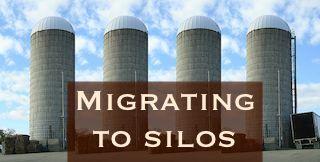 We’re back for Part 3 of the series on website silos. In this part, we will discuss how to take your existing website and organize it in a silo structure. It’s not going to be a trivial task.
We’re back for Part 3 of the series on website silos. In this part, we will discuss how to take your existing website and organize it in a silo structure. It’s not going to be a trivial task.
Overview
Like I said this won’t be a trivial task and you should expect to have a couple of hiccups along the way. The best way to prevent those issues is to plan ahead.
Then, check any of the points of risk once you are finished with migrating your site over to the new architecture.
At a high level, here is what is going to happen:
- Planning: Re-visit keyword research and analyze the existing content so you can map it to the new architecture. You will also need to figure out what posts/pages will have their URLs change, plus any plugins or custom code that will break.
- Implementation: Here is where it gets exciting. You will be creating the main silo pages (parent) and ensuring the content pages (child) are assigned to the right silo page. Any URLs that change will need to be accounted for by adding 301 redirects.
- Testing: You’ll be auditing your site to make sure that links are not broken and that the site architecture is how you planned.
- Continuous Improvement: Tweak any changes that need to be made based on the testing.
Planning
You should spend at least 50% of your time planning, maybe more. The implementation will take plenty of time but, trust me, everything will go more smoothly if you methodically formulate your plan of attack.
Keyword Research
The keyword research needs to be comprehensive. The keyword list should be long – long enough for each of the silos (or subsilos) to have at least 5 pages of content. That is to say, each of the silo pages (parent) should have at least 5 pages (child). It is okay if you don’t use all the keywords that you find but it will be valuable to have a long list of keywords to refer to in the future.
So, here is an illustration for the parent and child pages:
Again, you want this list to be very thorough and don’t be shy about having a lot of long tail terms listed.
Architecture
Think about
the end user…
The architecture is just how the site content will be organized.
That’s it.
I know you’re hoping for something more because it’s a big word and it sounds complicated.
The website architecture is actually a simple thing so don’t be scared away from the concept. Here’s what we do…
Using the keyword research, map out the new silo structure. You will be grouping the related topics to be under one silo. There isn’t anything magic about this process.
Think about the end user, the visitor, on your website and how they would like to navigate through your site. Imagine how your website would look if it was in book form. Pretend like you’re writing the table of contents.
Analyze the Current Content
Next, you need to figure out how your existing content lines up with the new site architecture. You’ll need to have a full list of all your posts and pages – every URL on your site. You can refer to your sitemap or check google using the “site:” query in the search field. The sitemap for your site is the best option.
Refine the content…Rework the content if needed.
You should use your traffic data from Google Analytics to analyze which pages are getting very little or no traffic. Review the content on those pages to determine if they need to be reworked or refined to add more value. They might need some adjustments to fit nicely within the new site structure. Alternatively, it might be time to remove those pages if they are not really serving your audience.
Once you have the list of winners on your site (the pages you will be keeping), then you can align them to the correct silo.
Analyze the Fallout For URL Changes
Most likely, you will have a number of pages that will have a URL that is changing as a result of the new silo architecture.
This can be a major problem if you do not plan for it. The old URLs would show up as 404 errors for visitors and for the Google crawlers. It’s a very bad thing. In addition, the backlinks pointing to those pages will not be counted for your website. So, what can we do?
Make a list of those pages along with the new and old URLs.
We can take care of all the issues with a simple 301 redirect in your .htaccess file. For now let’s just keep the list of new and old URLs along with the redirect lines for each…We don’t want to make the update until the new page is actually published.
This will need to be added to the .htaccess file:
Redirect 301 /old-page http://your-domain.com/silo–1/new-page
Redirect 301 /old-page2 http://your-domain/silo–2/new-page
You can make the addition using your ftp application, through the file manager on your cpanel, or (probably) using the SEO plugin on your site. Regardless of the method you use to make the change, you should absolutely make a back up of the file. You can simply copy the .htaccess file and rename it something like “.htaccess-old”
Analyze Any Other Fallout
There might be other things that change that will cause issues with plugins, any custom updates on your theme, or anything that might have been hard coded. Now, if you’re anything like me, then you might have forgotten some of the changes that you’ve made over time.
Take a look at all of your plugins, theme files, and configuration for plugins and themes. Maybe you’ll remember something as you are reviewing.
Even if you check & then double check, something might still break…
If you find anything out of the ordinary that might break, make note so you can address it later while implementing the silo.
There is still a good chance that something will still break. That’s okay. That’s exactly why we want to spend plenty of time planning and thinking ahead to minimize the issues when they do arise.
Implementation
Now we’re getting to the fun stuff. Before we get started on the actual re-architecture, we need to make a back up of your website.
Back it up
It’s probably best to use a plugin like BackWPup but if you know how to do this manually that’s fine too. The important thing is that there is a back up available if things go terribly wrong.
Most hosting companies have some form of weekly or daily backups. However, if you aren’t paying for a “premium” or “pro” level of hosting (i.e. if you have shared hosting), then you should double check that the last backup is actually recent.
Check with your hosting company on how to verify the date of the last backup.
Set Up the Main Silo Pages
Now, you can create the top level main silo pages. These page should not have a parent page selected. As we mentioned before, the main silo page should have some content not just links to the child pages in the silo – aim for 500 – 1000 words.
Each of the main silo pages should have a link to each of the child pages, preferably in the content. If you can’t work that into the content, you can add a line or two at the end noting some related articles with the links. It should be natural to add the links since the sub topic pages should be very closely related.
Migrate the Existing Posts to Pages
This is one of the more time consuming tasks in the process. We will be creating a new page for each post and moving over the content. Here is the process I follow each time:
- Create a new page and title it appropriately. Usually, that’s the same title as the post.
- Update the URL as needed. Don’t worry if the parent page does not show up yet.
- Copy the “Text” view of the existing post and paste it in the new page. Update any other details regarding the content – for example, be sure to update meta description or title in your SEO plugin if needed.
- Select the appropriate parent page for the silo.
- Set the original, existing post as “Private.” I do this to ensure that the if anything goes wrong with the new page that I still have the original post to refer to.
- Repeat this until all the posts are converted to pages that align to your silo structure.
- It is worth it to double check that your pages have the correct hierarchy. Just click on the “All Pages” view and you can quickly see all the pages, plus the silo structure.
Make sure that your content pages (the child pages) do have links to the main page of the silo. I like to include that link early in the content, even in the first paragraph. It should be easy given the topic-subtopic, parent-child relationship.
In addition, the content pages should have links to the other pages in the silo. It should be natural to add the links within the content since the topics are so closely related. Now, you don’t have to go overboard and link to everyone of the other pages in the silo but I like to have at least two of them.
Update the Redirect Rules in .htaccess
We should already have the list of pages that will have a URL change from the step above, Analyze the Fallout For URL Changes. You have a couple of options to make the update.
For most people, the SEO plugin is the fastest way to update the .htaccess file
The first option is using an SEO plugin on your WordPress Dashboard. You likely have an SEO plugin (like SEO by Yoast) installed that will allow you to add to the .htaccess file. It’s pretty simple to copy and paste in the lines, then save the changes. You can simply type in the old URL and make sure that it redirects to the proper page. Be sure to test each one!
The second option is head over to the File Manager in your cPanel. Be sure to click the checkbox to show hidden files. You should make a backup of the .htaccess file by copying it and renaming it something like “.htaccess-old”. Then, edit the .htaccess file and add the redirect lines at the end. Save the changes and test each of the old URLs.
Here is how you can make the update in the SEO plugin.
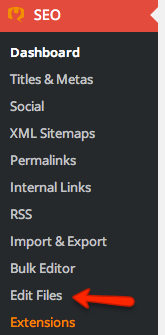
Click on the Edit Files option
Set up the Menu
Configure and set up your top navigation menu to have links to the main silo pages. This should be as simple as using the built-in Menu feature in WordPress – as long as your theme supports Menus. Most themes do so you should be in good shape.
Most of the time you can use the main silo topic as the menu title. However, if the silo topic is a long phrase, you should consider shortening it so it will fit well in the navigation menu. The other consideration is keyword density if the menu titles contain keywords, and most of the time they do.
Don’t be afraid to use a partial match keyword phrase in the menu but be careful if every single one of the silo topics uses the main keywords. If that is the case, then you should consider the use of synonyms or related words to keep the keyword density in the right range.
Testing
Please don’t skip testing…
Now, you get to check on any issues. There is a good chance you missed something. It’s okay it happens and it’s better if you find the issue before your users do.
- Check the menu links and any sidebar or footer navigation links.
- Check on each of the main silo pages (parent) and make sure they are properly linking to the content pages (child).
- Manually enter the old URLs to make sure the redirect code in the .htaccess file is working properly. I know you checked it before, but it is worthwhile to check it again. There maybe some backlinks out there and you don’t want to lose the link juice!
- Check to make sure the Analytics Code is running. Here is how you do it: https://support.google.com/analytics/answer/1008083?hl=en
- Use a broken link checker to find any broken links.
- Review Google Webmaster Tools closely over the next week. You may see some crawling errors show up.
Continuous Improvement
Over time you will probably want to add more content to your site. Hopefully, you when you identify new content that you want to add to your site, it will fit into one of the existing silos.
If not, you should investigate creating a new silo for a new set of topics. This is likely for an authority site or even a smaller site that you are expanding.
Should I use a silo structure on my Authority Niche Site or Affiliate Site?
Probably not. If you’re not familiar with a silo structure, it’s a well planned out way to architect your site. It leads to a very organized structure and URL structure. (Read the gory details here.)
Sounds great right? Well, it is in theory (like communism), but in practice, it’s really hard to plan out. You’ll do your best to plan out the structure, and then, your assumptions will be wrong somewhere along the way. It’s hard to change the structure after it’s in place — while it’s possible, you’ll end up with a bunch of 301 redirects to make things right.
Get all my templates & systems for niche sites.
The silo provides some really great SEO benefits. But when you peel back the layers of the onion, you’ll see that you can get the same benefits with less planning and more flexibility.
I recommend you just interlink your site really well. That means you should:
- Link to old posts from your new posts.
- Link to your new post from your old posts.
Number 1 is pretty easy because you can do that as you go.
Number 2 is harder because you have to constantly go back and add links to your old content.
The general idea is that you’re passing link juice (i.e. authority) throughout your site.
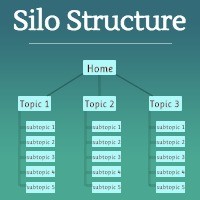
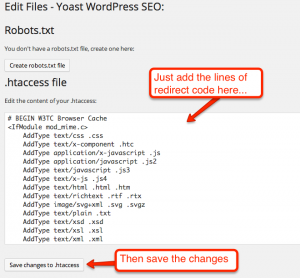
Thanks for this article! What if I have a small – medium size almost brand new site. The purpose is to build authority and sell an app at this time, probably more related apps or products/services later…
Right now there are only a few pages. I’d to start a blog on it. Would those blog posts also be set up as pages? That makes sense on the SEO side as you mentioned above, but not with the WP structure. The plan is for one blog post a week. That seems a bit messy when set up as pages. What are your thoughts on this?
Hey Jessica, Sorry on the delay! You’re right! Make them blog posts for the blog. 🙂
Mine is almost the same scenario, please let me know how to handle this scenario.
Hello Doug!
Thank you for this post.
would you recommend to remove internal links (or make them nofollow) to make a sitemap looking more like a silo architecture? Links between silos? Links from top to down?
Typically, the link in the header main menu to homepage breaks the silo concept.
Thx!
nice article 😀
I am a big fan of building silo framed websites. I have used Network Empire’s silo plugin to help build mine. It is easy to install and you can then enter the topic headings into the plugin and it will create the proper URL structure. Also,they recommend not having a drop down menu on the front page as that dilutes the themes within the silo. Rather you have the top level silo’s in the menu bar and then the categories within that silo appear on a sidebar menu once you have gone to the silo page. I hope that this has been helpful.
One can also use the Ptypeconverter plugin from the WordPress plugin repository to quickly convert posts to pages and vice versa.
This saves times if you have a lot of blog posts already published on your blog and you want to quickly turn them into pages without manually adding new pages and copying and pasting the text from your post editor to the new pages.
Doug, great tips on siloing a site.
Very helpful article.
Thanks Doug 🙂
Really an awesome article this is.. Thanks a Lot Doug…
So, in your examples, the main silo pages are the doors to that silo, and not the actual page I want to rank for?
Why do we make our content pages instead of posts?
Because the URL structure for posts is already set (blog/post-url).
Pages allow you to be more specific with what you want your URL/architecture to be (blog/parent-topic/blog-post-url)
Hi Doug,
How do you structure the home page?
Do you use a static front page? Or do you use some plugin like visual composer?
Hey, I set it up with a static page with some recent blog post snippets, like the Wirecutter or Sweethome.
Thanks for such a great article!
I want to set up my own silo…
And I understand the parent and child option, I can see that…
But I’m unclear on the topics and subtopics.
I am using a category for pages widget…
And want to optimize my category pages
So can you explain what I set the category too for each sub topic?
Lets say my TOPIC is EFT Tapping
and my sub topics are what is eft tapping & eft for business success… etc
Do they all need their own category?
Or do they all go under the TOPIC category of EFT Tapping?
Or do I have the TOPIC as the category and the subtopics as tags?
And if I do use tags, do they still all go under the eft tapping topic?
I hope this makes sense, and would appreciate your advice if possible, thanks!
Kai, Thanks for checking it out!
Categories and tags are a separate idea — different than silos. I just pay attention to the category, but it’s totally up to you. I consider the category since I may use that for list building later.
Hi Doug!
I’m trying to figure out where keywords should appear in the URL
Let’s say my longtail keyword is “Wooden chairs for the kitchen”
Which URL structure is better?
A. http://www.example.com/chairs/kitchen/wooden
B. http://www.example.com/chairs/kitchen/wooden-chairs-kitchen
I guess my question is, if part of the keyword already appears in the parent’s slug, should I insert it again in the current slug?
I’ve been using example A mostly but Yoast plugin warns me about it saying: “(Part of) your keyphrase does not appear in the slug. Change that!”
Any advice would be great
Google ignores the slash, so I think A would be best as you’re not repeating keywords in the URL.
Is it good or not to have category url show in subtopics etc or we can remove and still create silo structure that will work ??